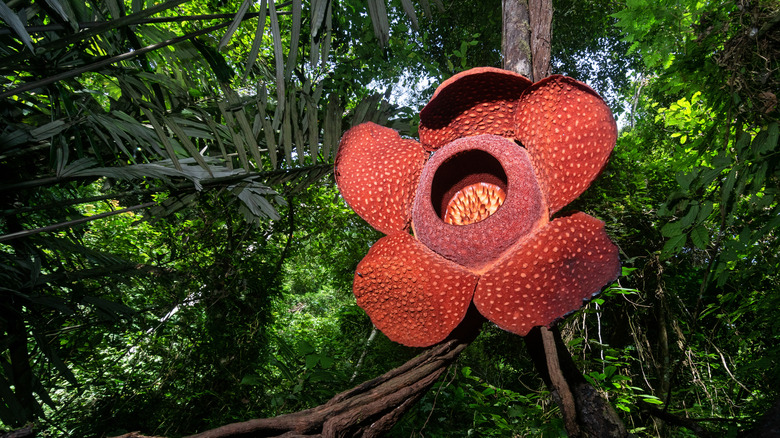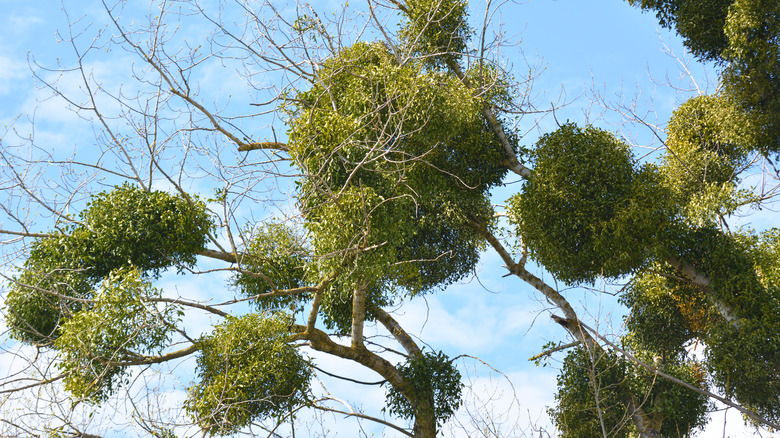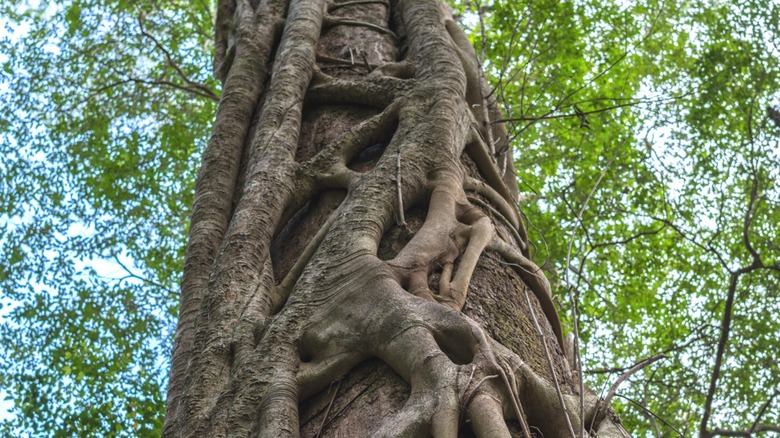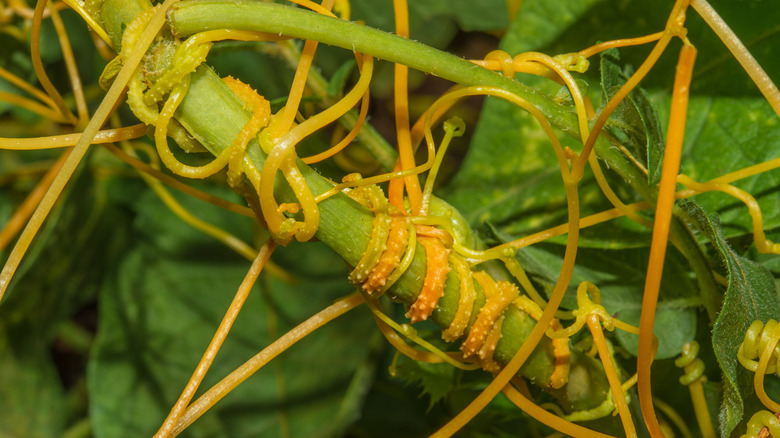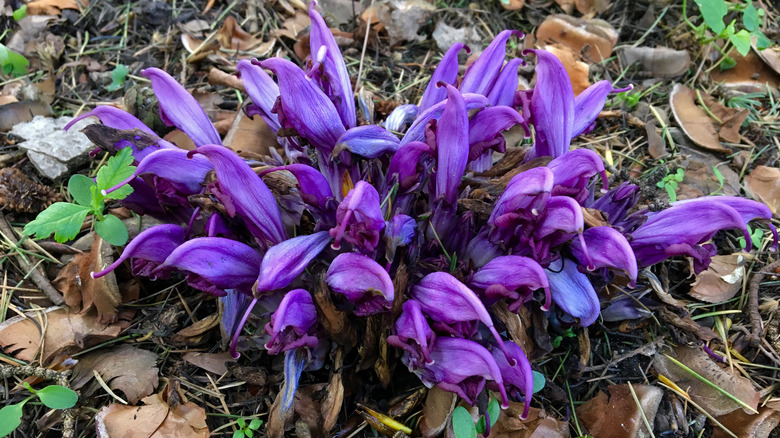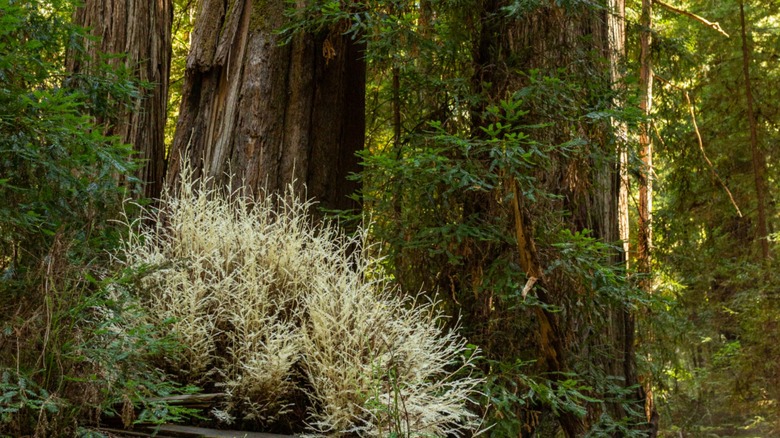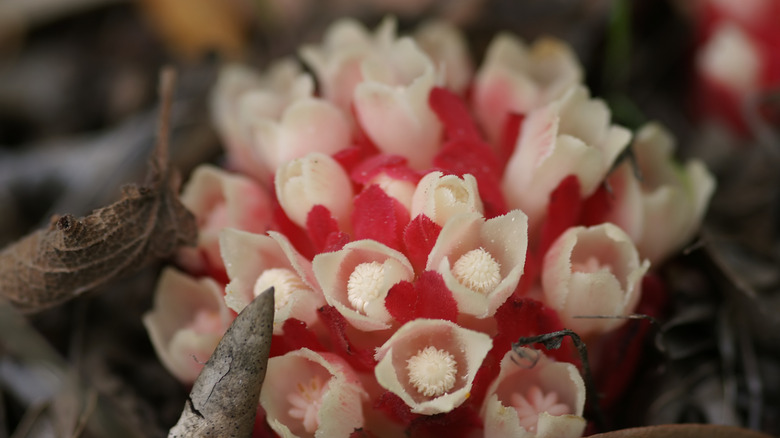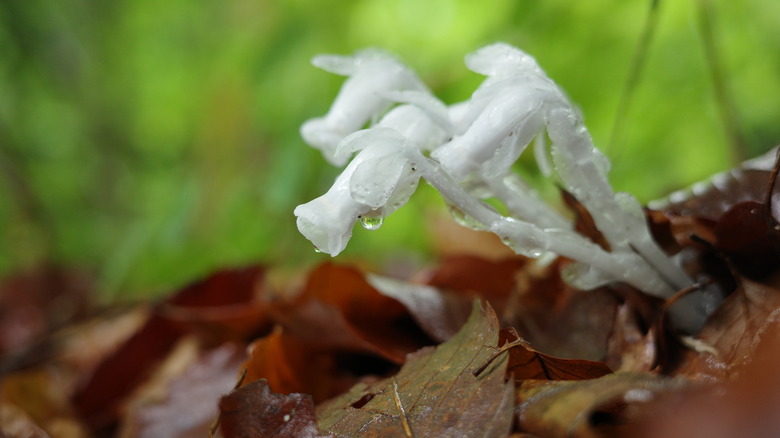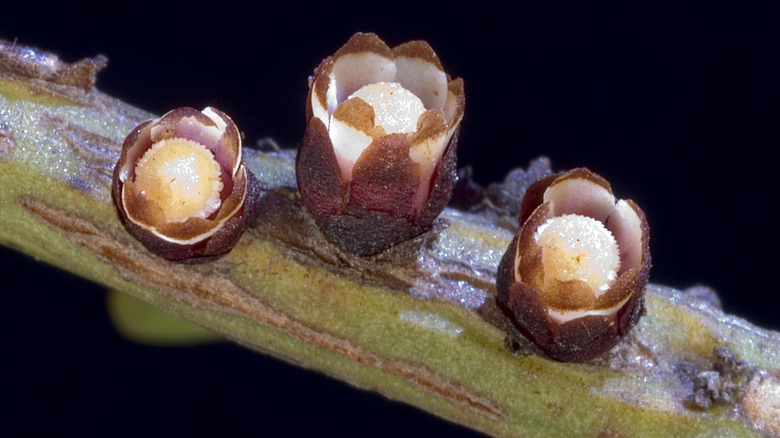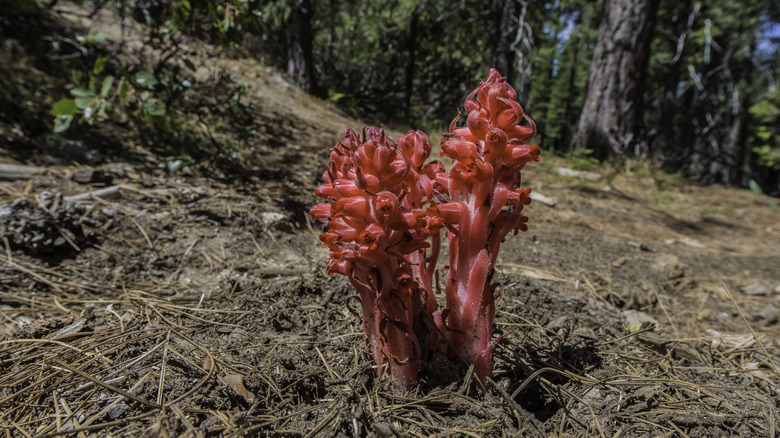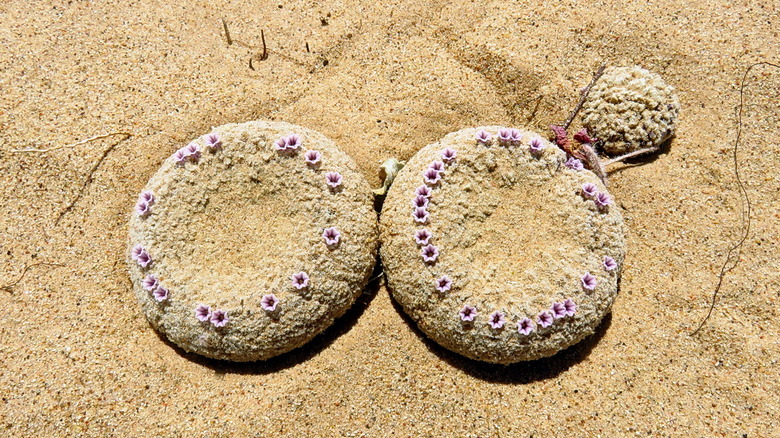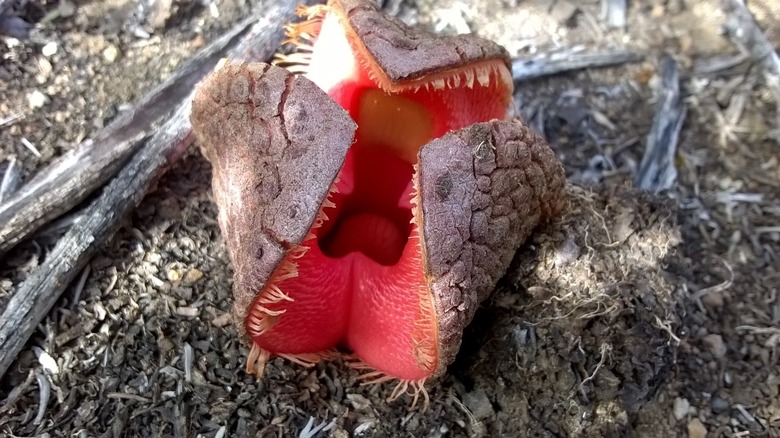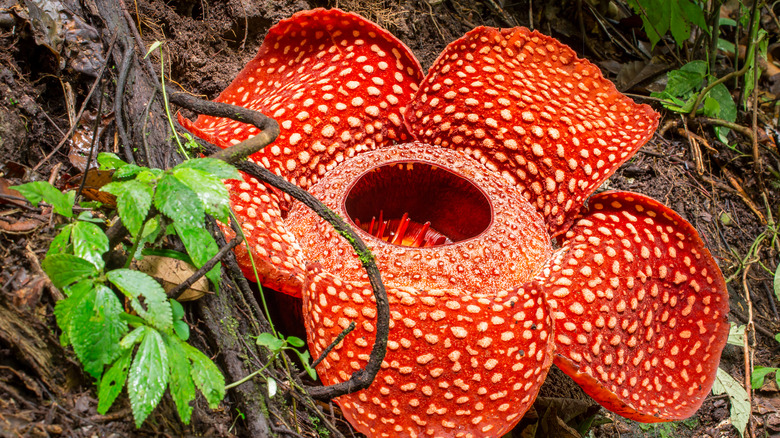The Weird World Of Parasitic Plants
We all have a fairly clear idea of what plants are, with roots drinking water from the ground and green leaves to catch sunlight for energy. However, some plants don't like to play by the rules, and even challenge the idea of what a plant is. Enter parasitic plants, the bizarre botanical species that get some or all of their energy and nutrients by stealing them from fungi and other plants. Some of the world's strangest vegetation, they accomplish this by growing on or even inside other plants. In the world of parasites, leaves, roots, and even stems are optional, and some are only recognizable as plants because they flower.
While they may seem like pests, parasitic plants can play important roles in ecosystems. According to a study in Plant Physiology, they can help improve biodiversity, preventing any plant species from growing out of control and taking over an entire area. This includes invasive species, which can easily run rampant, choking out native species and leaving entire ecosystems in ruins. Some also carry cultural significance in the places they grow. Clearly, there's a lot more to the plant kingdom's weirdest subjects than meets the eye — that is, if you can even find them to look at. Many spend most of their lives completely hidden from view.
Mistletoe
Best known as a Christmas decoration, many people may not realize that mistletoe is a parasite. Mistletoes are an entire group of plants that can only grow parasitically in the branches of trees. Some are fully parasitic, but the familiar kind is actually a hemiparasite — a plant that gets only some of its needs met through parasitic means. These plants are still green, harvesting energy from sunlight. Because they never touch the ground, they get water and nutrients by stealing them from a host tree. Most trees can comfortably sustain a few mistletoe plants but will start to struggle with too many.
Mistletoe is named after bird poop. It comes from old Anglo-Saxon words mistel (dung) and tan (twig), from an old belief that the plant grew from bird droppings. An old belief which, as it happens, turned out to be true. In winter, the berries are a valuable food source for birds, and the seeds pass through the bird's digestive system completely undigested, germinating on any tree branch they end up on.
Easily spotted in winter after trees drop their leaves, mistletoe has always been sacred to the Druids of Northern Europe. In his book, "Historia Naturalis," the Roman philosopher Pliny the Elder writes that the Druids harvested it during the Winter Solstice, using a golden sickle. Reportedly, they placed great significance on it growing without touching the ground, never allowing even the cut pieces of it to do so.
Strangler fig
Like mistletoe, strangler figs grow from seeds left high in the branches of trees. Unlike mistletoe, these strange trees can become a lot more deadly to their hosts. Strangler figs begin their lives not as parasites but epiphytes — forest plants that grow harmlessly in the branches of trees, getting all their water from rain and mist, and surviving off nutrients they find on the surface of branches. As the figs grow, they trail their roots downwards, wrapping around the host tree's trunk, until they eventually reach the ground. When they do, they start to behave more like a parasite, often encasing the trunk of the host tree and strangling it. Often, the unfortunate host tree dies off, leaving only the fig in its place, with a hollow space where its victim once stood.
This sounds at first like a very one-sided relationship, with the strangler fig constricting its host's trunk, cutting off its roots from water and nutrients, and even blocking the sunlight from its leaves. Some researchers have found though, that the strangler figs may give some benefit to their hosts. As Science reports, trees being smothered in the deadly embrace of a strangler fig are much more likely to withstand storm damage. With some tropical storms being strong enough to topple trees, strangler figs can help their host trees to stay anchored in the soil, while acting like a living suit of armor to protect their trunks.
Dodder
Cuscuta, better known as dodder, is a bane to gardeners. There are 150 species of this parasitic vine worldwide, but they're most likely to be found in North America. These plants grow as a messy tangle of spaghetti-like strands that can grow dense enough to completely wrap the plants they're infesting. Mostly lacking chlorophyll, dodder can be pale green, yellow, orange, or even red. If it has any leaves at all, they'll appear as little more than tiny stubs.
Dodder is part of the Convolvulaceae family of plants, which means it's related to morning glories and sweet potatoes. While sweet potatoes are best known for their roots though, dodder doesn't grow its roots into the ground. Once its seeds germinate in soil, a dodder sprout has just 5-10 days to find a host plant to attach to, or it will die. Once it grasps a host's stem, it wraps tightly around it and grows roots directly into the host's vascular system. Known as haustoria, these vampiric roots suck up the host's sap for nutrition as the dodder's vines entangle it further.
Dodder is weakly photosynthetic, but it seems like this is an evolutionary leftover. It doesn't produce enough energy on its own and can't survive without a host. Widely considered a pest species, farmers and gardeners alike go to great lengths to prevent dodder — once it takes hold of a host plant, infestations can be difficult to remove. Mercifully, as an annual, they don't survive the winter.
Purple toothwort
Lathraea clandestina gets its bizarre name of purple toothwort from its vibrant purple flowers, though it's not entirely clear what it has to do with teeth. They appear in early springtime, growing directly out of the ground in colorful little clusters, finding their way to the surface from amid loam and leaf litter. Flowers growing on a forest floor aren't unusual in spring, so it may be easy to overlook the fact that these plants have no leaves.
Native to Western Europe, purple toothwort is a holoparasite, meaning it's so specialized to live parasitically that it has no chlorophyll. Not needing any light, this plant lives almost its entire life below ground. There, it attaches itself to the roots of trees, like hazel and willow, stealing all the nutrients it needs. Interestingly though, the toothwort doesn't seem to do any harm to the trees it grows from. Without needing to waste any energy growing things like leaves and stems, the plant can pour all its resources into bright floral displays, which are the only thing it ever grows above ground. While the idea of a plant that can't photosynthesize may seem bizarre, in the world of parasitic plants, it's far rarer to find those that do.
Albino redwood
Wander through the sequoia forests of California, and you may be lucky enough to spot a rare forest phantom. Ghostly albino redwoods are mutants, with their pale leaves completely devoid of chlorophyll and unable to harvest sunlight. There are only around 60 of these strange trees in the world. Not needing to reach for the sunlight like other trees, the albino redwoods don't tend to grow tall, reaching a maximum of around 30 feet. This is a fair height for some trees, but tiny for a redwood. For comparison, the world's largest sequoia stands at 275 feet tall!
Unable to use sunlight themselves, the albinos are entirely dependent on other trees nearby for the nutrients they need to survive. They grow as offshoots from larger parents, but while they've been described as parasites in the past, this may be a mischaracterization. Per Atlas Obscura, botanists studying the albino redwoods have found that these mysterious plants may play important roles in forest ecosystems. Most notably, they detoxify the soil, sucking up twice as many heavy metals from the ground as the other trees nearby. The fact that forests near industrial areas tend to have more of them suggests that keeping the soil healthy is the reason they grow. If a forest behaves like a single giant organism, these spectral trees are its liver.
Vampire cups
Vampire cups are the flowers from cytinus, an entire genus of parasitic plants native to Southern Africa, also sometimes known as ground roses. These plants are endoparasites, meaning they grow entirely inside other plants. With no need for roots, leaves, or even stems, these strange parasites spend most of their lives as little more than a network of fine filaments inside their host plant's tissues. In many ways, they behave more like fungi than plants. Their flowers though, remain distinctly plant-like, appearing in colorful clusters on the forest floor.
A paper published in the journal Plants People Planet describes cytinus as "arguably one of the most enigmatic [genera] in the plant kingdom" for how little known and understood it is. Completely endoparasitic plants like cytinus have only evolved four times, as far as botanists are aware, which makes them extremely difficult to even find, let alone study. Cytinus only emerge from hiding to flower and produce seeds. Finding them becomes even harder because of the fact that cytinus live almost exclusively inside the roots of their host tree, occasionally sending flower shoots up to the ground. These shoots are the only thing cytinus ever grows that resemble the stems of most plants. They're studded with vestigial leaves, like scales, which will never see daylight and could never photosynthesize even if they did.
[Featured image by Hans Hillewaert via Wikimedia Commons | Cropped and scaled | CC BY-SA 3.0]
Ghost plant
Known to botanists as Monotropa uniflora, ghost plants get their name for their eerie white appearance. Translucent and glassy-looking, the ghost plant's colorless shoots can be seen across most of North America and parts of Asia. The otherworldliness of these strange flowers was an inspiration to the poet Emily Dickinson, who discovered some as a child and later wrote about them, saying, "maturity only enhances the mystery, never decreases it." Dickinson was certainly not the only one captivated by the mystery of the ghost plants. Also known as ghost pipes or Indian pipes, these plants only surface from below the soil to flower, growing a cluster of shoots, each with a single white flower. Eerily, these flower stalks look like fairly normal wildflowers apart from their complete lack of color.
Unlike many parasitic plants, the ghost plant doesn't feed off other plants, instead living parasitically on fungi. Plants and fungi usually share a symbiotic relationship, trading resources with each other for mutual benefit through a mycorrhizal network. The ghost takes advantage of that arrangement. A type of parasite known as a mycoheterotroph, it takes all it needs from the fungi while giving nothing back — though, at the same time, they're arguably not parasitic because they don't seem to harm the fungi at all. The ghost plant is so specialized in this lifestyle that it doesn't have much of a root system of its own. It doesn't need one. Its short roots only exist to harness fungi.
Stemsuckers
Many plants are home to insect parasites, and gardeners will easily recognize the signs of an aphid infestation on their plants. A collection of small dark specks, congregating around the plant's shoots and spelling trouble for the plant in large numbers. Remarkably though, there are some parasitic plants that behave very similarly. Stemsuckers are tiny, just millimeters in size. Seen on the stem of their host plant, they can easily be mistaken for insects at first.
Also known as pilostyles, stemsuckers can be found in various places around the world, including Western Australia, East Africa, and North America. One variety, Pilostyles thurberi, is native to the deserts of the Southwestern U.S., where it can be found growing on woody shrubs. These strange little plants live almost entirely inside the stems of their host, growing their haustoria roots into the shrub's tissues for nutrients. Stemsuckers are only seen when their tiny flowers break out from the host plant's stems, with clusters of them appearing all at once. Each flower is an individual plant, forming a whole community of parasites on a single unfortunate host.
[Featured image by Kevin Thiele/Flickr | Cropped and scaled | CC BY 2.0]
Snow plant
The snow plant's scientific name is Sarcodes sanguinea, which loosely means "bloody fleshy thing" for its striking appearance. Bright red and very unplantlike, it gets the name of snow plant because its flowers often start to appear on the ground in early spring, extremely easy to spot amongst any snow still on the ground. This plant lives parasitically but seemingly harmlessly off fungi, getting all its nutrients in a one-sided relationship with mycorrhizal networks below the soil.
The snow plant's red hue also makes it unique. It's the only mycoheterotrophic plant that's brightly colored rather than being white or brown. This plant stays mostly underground, and all of its subterranean stems remain colorless with the bright red color being confined to the flower stalks. Why exactly the flowers are such a vibrant red is a mystery, though some botanists think it may be to attract insects to pollenate the flowers. Oddly enough, the snow plant is a distant relative of the blueberry. It even produces fruit, though they're not especially appetizing and definitely don't go as well in muffins.
Pholisma Sonorae
In the Sonoran desert, if you're lucky, you might be able to spot this unusual plant, though at first, you're more likely to mistake it for a mushroom. The only part of Pholisma sonoae to show above the surface are the plant's bulbous flower heads, standing just above the surface on a fleshy stem. Once above the hot sand, these plant-shrooms start to bristle with tiny purple flowers.
These parasites grow on the roots of other plants, and can sometimes grow even larger than the plants they feed from — though you'd never realize it from above the ground. Pholisma sonoae isn't entirely parasitic either. It can absorb water on its own and will share it with its host plant during droughts. Also known as sand food, this plant was once collected and eaten by Native Americans, who baked and boiled the roots. Technically speaking, it's a herb, part of the borage (starflower) family, which also means it's related to forget-me-nots. In modern times though, if you find one of these rare plants, you should leave it alone rather than eat it. Pholisma sonorae is an endangered species, threatened by the loss of both its sandy habitat and the host plants it depends on for survival.
[Featured image by Vahe Martirosyan/Flickr | Cropped and scaled | CC BY-SA 2.0]
Hydnora africana
Hydnora africana looks like some kind of plant monster. Its tough, scaly-looking flower buds burst up from below the ground before opening into bizarrely fleshy blooms that look like gaping three-jawed mouths and smell like rotting meat. This plant beast no longer has the slightest trace of any leaves, but it does have stems, studded with suckers that attach to the roots of one or more nearby plants to suck nutrients from. A healthy hydnora will have a collection of these stems, eventually sending up several monstrous flowers all at once. As a paper in Plants Planet People notes, Hydnora africana is sometimes considered the strangest plant in the world. Exceptionally difficult to cultivate, it's quite a mysterious plant and may hide underground for years before flowering.
Native to Southern Africa, these plants are pollinated by beetles attracted by the foul scent of their flowers. Shaped similarly to pitcher plants, the flowers temporarily trap the beetles they attract, keeping them contained for long enough to ensure they pick up or drop off some pollen, before releasing them to go and find another flower. Once pollinated, the flowers slowly grow a fleshy fruit. Despite the rancid scent of the flowers, the starchy hydnora fruit are not only edible but apparently quite tasty and slightly sweet when baked over a fire. Animals, from porcupines to baboons, dig them up to eat, scattering the seeds in droppings.
[Featured image by Seth Musker/iNaturalist | Cropped and scaled | CC BY 4.0]
Rafflesia
Rafflesias only grow in the rainforests of Southeast Asia, where there are several different species of them. One of those species, Rafflesia arnoldii, produces the largest single flower in the world. With its fleshy appearance and stench of rotten meat, a rafflesia flower also generates heat, which is an unusual trait for a plant. Its job is to attract carrion flies as pollinators. The foul odor and buzzing flies sometimes earn rafflesias the nickname of corpse flowers — not to be confused with another plant, the titan arum, which is also sometimes called a corpse flower. This plant, not a parasite, has the largest inflorescence in the world, but it's made up of thousands of tiny flowers rather than being a single large one.
The rafflesia is entirely endoparasitic, with no roots, leaves, or stems at all. It lives entirely inside tetrastigma vines as little more than a bundle of filaments, absorbing all it needs directly from its host's tissues. The vine, in turn, is a climbing plant that depends completely on the trees around it to help it reach the light. Per Harvard Magazine, infected vines show no signs that the rafflesia is even there, with the parasite so intertwined with its host that the two are barely distinguishable. That is, until the rafflesia starts to form flower buds, taking months to grow to enormous proportions. With barely anything to call a body of its own, the plant pours all of its energy into growing its huge flowers.
